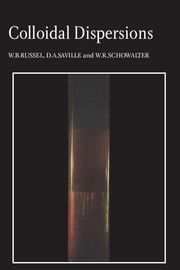Book contents
- Frontmatter
- ACKNOWLEDGEMENTS
- Contents
- Preface
- Units and physical constants
- Mathematical symbols
- 1 A Survey of Colloidal Dispersions
- 2 Hydrodynamics
- 3 Brownian Motion
- 4 Electrostatics
- 5 Dispersion forces
- 6 Forces due to soluble polymer
- 7 Electrokinetic phenomena
- 8 Electrostatic stabilization
- 9 Polymeric stabilization
- 10 Equilibrium phase behavior
- 11 Particle capture
- 12 Sedimentation
- 13 Diffusion
- 14 Rheology
- Appendix A Measured properties
- Appendix B Vector and tensor notation
- Author index
- Subject index
8 - Electrostatic stabilization
Published online by Cambridge University Press: 05 August 2012
- Frontmatter
- ACKNOWLEDGEMENTS
- Contents
- Preface
- Units and physical constants
- Mathematical symbols
- 1 A Survey of Colloidal Dispersions
- 2 Hydrodynamics
- 3 Brownian Motion
- 4 Electrostatics
- 5 Dispersion forces
- 6 Forces due to soluble polymer
- 7 Electrokinetic phenomena
- 8 Electrostatic stabilization
- 9 Polymeric stabilization
- 10 Equilibrium phase behavior
- 11 Particle capture
- 12 Sedimentation
- 13 Diffusion
- 14 Rheology
- Appendix A Measured properties
- Appendix B Vector and tensor notation
- Author index
- Subject index
Summary
Introduction
As noted in Chapter 5, dispersion forces acting between similar particles suspended in a chemically different liquid are inevitably attractive, providing a driving force toward macroscopic phase separation. Hence, maintenance of a dispersed state requires an opposing interparticle repulsion, most commonly achieved through electrostatic forces in aqueous dispersions or the adsorption of soluble polymer in either aqueous or non-aqueous environments. Since all characteristics of colloidal systems change markedly in the transition from the dispersed to the aggregated state, the question of stability occupies a central position in colloid science (e.g. Verwey & Overbeek, 1948; Napper, 1983; Hunter, 1987).
Even among unstable or aggregated systems, the nature or degree of aggregation varies. Following the convention of La Mer (1964), many authors have attempted to distinguish between flocculation, referring to loose aggregation, with highly porous flocs and/or particles held relatively far apart, and coagulation, with more closely packed flocs of particles in contact. Unfortunately, floc structure has been quantified only recently, leaving the classification ambiguous in many cases.
In the following, we distinguish instead on the basis of the strength of the attractive potential responsible for aggregation. Then the criterion becomes whether the system attains equilibrium in the period of interest. For attractions strong relative to the thermal energy kT, Brownian motion eventually eliminates all individual particles, producing a non-equilibrium phase whose structure is governed by the range of the attractive potential and the mode of aggregation.
- Type
- Chapter
- Information
- Colloidal Dispersions , pp. 258 - 309Publisher: Cambridge University PressPrint publication year: 1989
- 6
- Cited by



